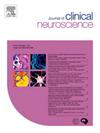White matter correlates of gait and balance dysfunction in essential tremor patients
IF 1.9
4区 医学
Q3 CLINICAL NEUROLOGY
引用次数: 0
Abstract
Background
Essential tremor (ET) is a syndrome characterized by both motor (tremor, gait, and balance dysfunction) and non-motor features like cognitive deficits, depression, sleep, mood, and anxiety disorders. The present study was conducted to characterize the clinical dysfunction and brain localization of gait and balance disturbances in ET patients.
Methods
174 ET patients and 150 matched healthy controls were evaluated. ET was diagnosed using the Consensus Statement on the Classification of Tremors, from the Task Force on Tremors of the Movement Disorder Society criteria. Participants were assessed by using a structured neuropsychological battery and validated gait scores. Diffusion tensor imaging (DTI) data comprising mean diffusivity, radial diffusivity, axial diffusivity, and fractional anisotropy were analyzed for all subjects.
Results
The mean age of essential tremor cases was 45.1 ± 14.08 years. Male: female ratio in ET cases was 2.5:1. Cognitive impairment was observed in a quarter of ET patients. A significant difference was observed in Berg balance scale scores, tandem gait missteps, and tandem stance time between ET cases and controls (p-value < 0.0001). ET patients with higher tremor scores and head tremors were more aged and had poor gait and cognitive scores (p < 0.0001). In our study, we observed poor gait scores significantly correlated with an increase in mean, radial, and axial diffusivities as well as a decrease in fractional anisotropy over various white matter clusters in the brain. No such correlation was observed among the controls.
Conclusion
The present study demonstrates a correlation between gait scores and DTI metrics suggesting a neuroanatomic basis for gait impairment in ET patients.
本质性震颤患者步态和平衡功能障碍的白质相关性。
背景:本质性震颤(ET)是一种以运动(震颤、步态和平衡功能障碍)和非运动特征(如认知障碍、抑郁、睡眠、情绪和焦虑障碍)为特征的综合征。本研究旨在了解 ET 患者的临床功能障碍以及步态和平衡障碍的大脑定位特征。ET 的诊断采用运动障碍协会震颤特别工作组的《震颤分类共识声明》标准。通过结构化神经心理测试和有效步态评分对参与者进行评估。分析了所有受试者的扩散张量成像(DTI)数据,包括平均扩散率、径向扩散率、轴向扩散率和分数各向异性:本质性震颤病例的平均年龄为(45.1 ± 14.08)岁。ET病例的男女比例为 2.5:1。四分之一的 ET 患者存在认知障碍。在伯格平衡量表评分、串联步态失误和串联站立时间方面,ET 病例与对照组之间存在明显差异(P 值 结论):本研究显示,步态评分与 DTI 指标之间存在相关性,这表明 ET 患者的步态障碍具有神经解剖学基础。
本文章由计算机程序翻译,如有差异,请以英文原文为准。
求助全文
约1分钟内获得全文
求助全文
来源期刊

Journal of Clinical Neuroscience
医学-临床神经学
CiteScore
4.50
自引率
0.00%
发文量
402
审稿时长
40 days
期刊介绍:
This International journal, Journal of Clinical Neuroscience, publishes articles on clinical neurosurgery and neurology and the related neurosciences such as neuro-pathology, neuro-radiology, neuro-ophthalmology and neuro-physiology.
The journal has a broad International perspective, and emphasises the advances occurring in Asia, the Pacific Rim region, Europe and North America. The Journal acts as a focus for publication of major clinical and laboratory research, as well as publishing solicited manuscripts on specific subjects from experts, case reports and other information of interest to clinicians working in the clinical neurosciences.
 求助内容:
求助内容: 应助结果提醒方式:
应助结果提醒方式:


